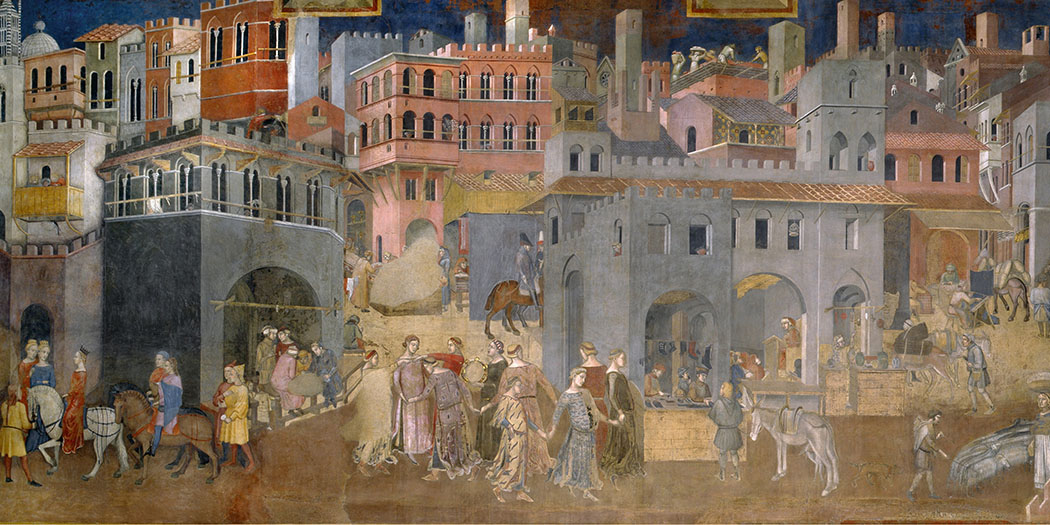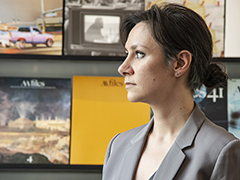The plague of 1347 marked the end of the Siena communal experiment. Can the current pandemic encourage us to rethink cities as spaces of care?
In 1338, Ambrogio Lorenzetti frescoed the main council hall of the commune of Siena with the ‘Allegory of Good and Bad Government’, offering one of the oldest extant representations of the idea of civicness in the western world. 1 Seven centuries afterwards, the frescoes seem to put forward a cautionary tale of sorts; while our cities are, arguably, more democratic and less violent than medieval Siena, a careful rereading of the ‘Allegory’ might reveal that contemporary public spaces resemble much more closely the scene labelled as ‘Effects of Bad Government’ rather than its positive counterpart. The open-air spaces of contemporary cities, not only in Europe but across the world, suffer from neglect from public authorities who struggle to pay for their upkeep, and suffer even more from a depletion of their social and political meaning, becoming, at best, receptacles of retail – and at worst places to avoid in the age of Covid-19. At the root of this predicament of public space is a crisis of the public sphere which has by now become almost a commonplace conviction in architectural debate. However, I believe that the notion of public sphere is something historically constructed, and more specifically constructed by the ideology of the modern nation state, which sought a clear separation of public and private that does not exist in many non-European contexts – as well as in pre-modern Europe. Refusing to acknowledge the need for this notion of publicness to change (and perhaps disappear) will not solve a widespread thirst for more communication, more transparency, more social fairness which we tend to translate into a call for more ‘publicness’ for lack of a better term. Rather, it might be worth considering what makes an urban space comfortable and open to social interaction without prejudice, without predetermining the role of the state. It is my suspicion that in recent years Eurocentric culture has become obsessed with the idea of recuperating publicness – ie the agency of the public sector over the space of the city – instead of looking ahead to new models of being together in the space of the city. In fact, we can argue that cultures that do not entertain such a rigid notion of publicness sometimes produced urban environments that are extremely pleasurable and adaptable.
In my opinion, the key category at stake in the existence of shared urban space is care, that is to say, a sense of reciprocal responsibility citizens need to have for each other, and for the world around them. My primary criticism of the concept of public space we inherited from the post-Renaissance European city is that this idea of care is transferred from the citizen to the state, wholesale; the state becomes the vehicle of all forms of care for the built (and unbuilt) environment, a strategy that appeared efficient for a long time, but which now, vis-a-vis an unprecedented ecological crisis, is showing its limits. This is particularly evident when it comes to depletion of natural resources, but, at a smaller scale, I believe it is also at the root of the dramatic neglect of our ‘public’ spaces, which suffer from the fact that citizens act towards them as passive consumers rather than conscious stewards.
Lorenzetti’s ‘Effects of Bad Government’ and ‘Effects of Good Government’ represent the same city, which is a recognizable version of Siena; in fact, they both represent a public space, possibly the Campo Square as seen from the very windows of the council hall. Although figures – both realistic and allegorical – abound, the shared urban domain is the ultimate protagonist of the frescoes, and the main difference between the two is the state of neglect and disarray marking the semi-deserted streets and squares of the ‘Bad Government’. It’s a ghostly landscape, characterized by the emptiness of the dark, gaping windows of its desolate buildings. On the contrary, the ‘Effects of Good Government’ is a celebration of small acts of love and care: from a group of masons repairing or expanding a building, to vases of flowers and birdcages appearing on most windowsills. The space represented in the fresco is what we could call a ‘public’ space, in the sense that it is an open-air urban environment under the jurisdiction of the city administration; however, there are no explicit markers of publicness, no street furniture or lighting, no police or signage, no paving even. What is depicted is an environment of public togetherness, rather than public authority – citizens take direct care of their town and each other, as we can see in the many activities that take place in the well-kept porticoes lining the streets. School lectures, craft, and trade occupy this grey area that is neither ‘private’ nor ‘public’, and yet can be considered as completely civic in terms of its use and perception.
The plague of 1347-48 did not only kill Lorenzetti himself: it also swept away the budding sense of civic engagement that had inspired his work. 2 In the wake of a terrifying pandemic, political and economic hierarchies became increasingly asymmetrical and rigid, as an elite crystallized around landowning and moneylending families. A counter-revolutionary spirit seized Siena – a city that had enjoyed a century of unprecedented broadening of political participation. 3 Before the plague, the highest political office in the city was covered by 54 citizens per year; as they would change every year, and the city counted a total of about 40,000 inhabitants, a male citizen would have roughly a 1 in 5 chance of serving in that position once in his life, not to mention the vast number of other offices available. Census limits were relatively low, and only the aristocracy was formally excluded from political life; immigrants were also eligible, as long as they paid taxes and had their domicile in Siena. In fact, as of 1300, almost half of the inhabitants of Italian communes were actually born elsewhere, 4 testifying to a remarkable degree of mobility and openness. If we omit the deplorable condition of women, Lorenzetti’s Siena was a promising model of participatory government, and it is precisely participation that made its government ‘good’.
Such a civic effort would come to an end in the wake of the plague; the social harmony portrayed by Lorenzetti did not survive the ravages of the pandemic, which exacerbated economic disparities and strengthened the wealthiest layer of the population. The participatory processes that had shaped Siena’s urban space before the plague required time, energy, and resources, but the pandemic required a radical redirection of these resources, precipitating the return to a much stricter form of oligarchic power.
For this reason, the original concept of what makes a ‘Good Government’ became, in the subsequent centuries, increasingly opaque, furthering the impression that a good government is a government that exercises a firm hand in the managing of subjects: a strongly public government. On the contrary, it had nothing to do with top-down administration, and all to do with participation. The political concept that most closely describes this process is ‘commoning’, an active engagement in the care of shared resources that has been widely theorized in the past few decades by thinkers such as Elinor Ostrom 5 to Massimo de Angelis. 6 It is a process that entails forms of personal responsibility that blur the distinction between private and public. I strongly believe that this sense of agency and care has to be restored if we want to produce urban spaces that are still meaningful for their users; that a possibility of direct engagement, or even the duty of direct engagement, are a prerequisite for streets and squares to be more than mere conduits for circulation.
This will only be possible if a more granular scale of informal social aggregation is encouraged as complementary to formal public administration – neighbourhood associations, block unions, local communities can all be effective actors.
I have two final motivations to advocate for ‘common’ space as an alternative to ‘public’ space – a social one, and an architectural one. From a social point of view, my skepticism towards the forms of publicness fostered by the nation state is motivated by the fact that while states do protect and help some of their citizens, they have also historically functioned as machines for the production of asymmetries, constructing and naturalizing racial, class, and gender hierarchies. Spaces of commoning on the contrary do not function by creating categories, but rather through simple presence and participation – so much so that premodern Siena could be quite inclusive towards newcomers (but was still structured enough to exclude women and extremely poor people).
Lastly, from an architectural point of view what I find enduringly alluring in Lorenzetti’s ‘Good Government’ is that buildings do not need to look all the same in order for urban space to have a form and a character. In the fresco we can notice a variety of styles, languages, and materials, as processes of commoning need to allow for individual expression. And yet there is an underlying ‘project’ to the way they are laid out to ring the Campo Square and the Via dei Banchi; there’s a shared endeavour to construct an environment that is more than the sum of the parts, and which, yet, does not need to neutralize the character of the parts in order to work. As a designer, I find this character of spaces of commoning extremely interesting, as their form becomes the legible index of a slow process of togetherness, rather than a linear imposition of a design.
There is no recipe for constructing a space of commoning; however, the first step we can take in that direction is to shift our attitude towards ‘public’ space, from one of consumption, to one of care. The long term result might be far from the monumentality and cohesion of Western public space as it was understood from the Renaissance onwards – but then again it is high time architecture opens up to alternative models of civicness. The 1347 pandemic signalled the end of the commoning experiment of Siena; it would be a beautiful vindication if the 2020 pandemic on the contrary opened up new energies to rethink the spaces of our cities as places of care rather than places of consumption.
1 Some key readings on the Lorenzetti frescoes are Nicolai Rubinstein, «Political Ideas in Sienese Art», in Journal of the Warburg and Courtauld Institutes 21, no. 3-4 (jul.-dic. 1958), pp. 179-207; Quentin Skinner, «Ambrogio Lorenzetti: The Artist as Political Philosopher», in Proceedings of the British Academy LXII, pp. 1-56; Randolph Starn, Ambrogio Lorenzetti: the Palazzo Pubblico, Nueva York, George Braziller, 1994; Chiara Frugoni, «Immagini troppo belle: la realtà perfetta», in Una lontana città: sentimenti e immagini nel Medioevo, Turín, Einaudi, 1983, pp. 136-197.
2 On the political background of Lorenzetti’s work see Alois Riklin, Ambrogio Lorenzettis politische Summe, Berna, Stämpfli, 1996.
3 On Siena’s political life in the 1200s and early 1300s see William M. Bowsky, A Medieval Italian Commune: Siena under the Nine, 1287 – 1355, Berkeley, University of California Press, 1981.
4 Marco Romano, La città come opera d’arte, Torín, Einaudi, 2008, p. 10.
5 Elinor Ostrom, Governing the Commons: The Evolution of Institutions for Collective Action , Cambridge, Cambridge University Press, 1990.
6 De Angelis, Massimo. Omnia Sunt Communia: On the Commons and the Transformation to Postcapitalism , Londres, ZED Books, 2017.




